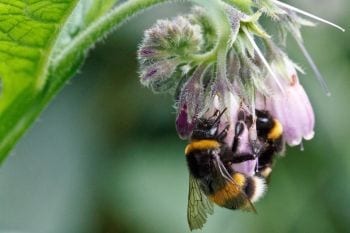
Flower strips sown into farmers’ fields not only attract bees but increase their numbers, new University of Sussex research has shown.
A two-year study of farms in West Sussex and Hampshire found that England’s most common bumblebee species saw significant population growth where targeted, bee-friendly planting schemes were in place.
A number of ‘agri-environment’ schemes have been introduced to try to halt and reverse the decline of bumblebees, whose numbers have been falling because of changes in agricultural practices that have largely removed flowers from the landscape, leaving the bees with little to feed upon.
Across the European Union, such schemes are now funded as part of the Common Agricultural Policy. In England, two tiers of environmental stewardship were in place between 2005 and 2014; Entry Level Stewardship (ELS) was open to all farmers, whereas Higher Level Stewardship (HLS) provided greater financial rewards for more substantial and rigorous schemes involving planting bee-friendly plots or strips along the sides of fields.
Plants were chosen for the popularity with foraging bees and included common bird’s-foot trefoil (Lotus corniculatus), common knapweed (Centaurea nigra), red clover (Trifolium pratense) and Alsike clover (Trifolium hybridum).
University of Sussex PhD researcher Thomas Wood, supervised by bumblebee expert Professor Dave Goulson, compared farms with and without HLS schemes to measure the abundance of bumblebee colonies.
He found significantly greater numbers of common bumblebees on HLS farms and, crucially, evidence of far higher nesting density, indicating population growth.
This is the first evidence that these schemes can actually boost the size of bumblebee populations.
Thomas said: “A consistent problem in assessing the response of bumblebees to agri-environment schemes has been that it is unclear whether a high observed abundance of bumblebees was merely an attraction of workers to sown forage patches or a genuine population level increase.
“Here we show for the first time that the management of uncropped land under Higher Level Stewardship can significantly increase the size of bumblebee populations.”
However, while common species the Garden Bumblebee (Bombus hortorum), Red-tailed Bumblebee (Bombus lapidaries)and Buff-tailed Bumblebee (Bombus terrestris) fared well, there was little recorded benefit to rarer species – such as the Large Garden Bumblebee (Bombus ruderatus) – that tend to stay closer to their nests when foraging food.
Thomas added: “The flower-rich strips on farms may be too few and too scattered in the landscape to benefit those species unable to cover larger distances.
Read more: Flower-enriched farms boost bee populations
The Latest on: Bees
[google_news title=”” keyword=”Bees” num_posts=”10″ blurb_length=”0″ show_thumb=”left”]
via Google News
The Latest on: Bees
- Everton 1-0 Brentford: Toffees Join Bees In Ensuring English Premier League Statuson April 27, 2024 at 11:52 pm
Luton's 2-1 defeat at Wolverhampton Wanderers meant Brentford's slim fears of relegation were behind them before kick-off, while Everton knew a third straight victory would also secure their place in ...
- Stardew Valley updates dig deep with 40 new mine layouts, fish frenzy fun and busier bees, but console farmers face a waiton April 27, 2024 at 11:52 am
Since the release of update 1.6 for Stardew Valley, various patches have been released for the game, the most recent being 1.6.6.
- Bees attack father and daughter at Las Vegas park, stinging them dozens of timeson April 27, 2024 at 1:00 am
Anyone attacked by bees is urged to run and get inside a car or building to limit the numbers stinging them. Iannucci says swatting them may only agitate them more, as would blowing on them, because ...
- Beekeeper Discovers Over 50,000 Bees in 100-Year-Old Farmhouse | Videoon April 26, 2024 at 7:00 pm
When a toddler had night terrors after telling her mother she heard monsters in the bedroom, a beekeeper found 50,000 bees in the wall.
- Get rid of bees this spring with these tips and methodson April 26, 2024 at 2:23 pm
Bees! These cute yet annoying insects like to come out of hiding in early spring, so if you think you'll be looking for bee removal options sooner rather than later -- then this guide is for you.
- How to get rid of beeson April 26, 2024 at 2:22 pm
Got bees? Don't put up with all that buzzing and stinging; here are some easy ways to get rid of bees this spring.
- Toddler Tells Mom She Hears Monsters in Her Bedroom. Beekeeper Discovers Over 50,000 Bees in the Wall (Exclusive)on April 26, 2024 at 5:55 am
A toddler's persistence about monsters in her bedroom led to an unbelievable discovery in the family's 100-year-old farmhouse. Ashley Massis Class, who goes by @classashley on TikTok, tried to ...
- How to get rid of bees without harming them (or yourself)on April 26, 2024 at 4:33 am
Bee removal isn’t easy to do yourself, but don’t buzz with anxiety. Call a bee removal specialist to relocate these pollinators.
- NYC building tiny homes for bees. Take the touron April 25, 2024 at 3:45 pm
New York City is building tiny homes for at-risk bee populations as part of an initiative called The Pollinator Port Project.
- Wild bees are the real climate heroeson April 25, 2024 at 9:00 am
If we want to continue eating fruits and vegetables, maintain forests, and fight climate change, we must stop focusing on only one of 20,000 bee species.
via Bing News










